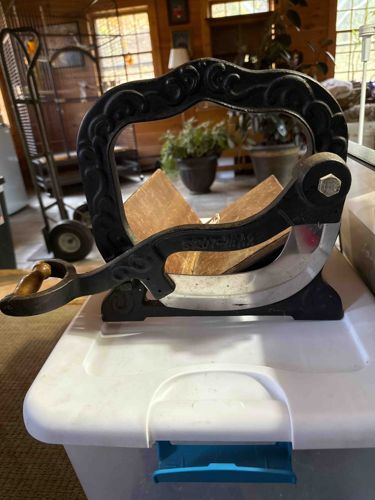
Brot-max German Bread Slicer
This is a vintage Brot-max German bread slicer, characterized by its robust construction and ornate cast iron framework. The primary material is blackened cast iron, forming the U-shaped or arching frame and the base of the slicing mechanism. The frame features intricate scrollwork and decorative motifs, indicative of late 19th to early 20th-century craftsmanship. The slicing blade appears to be made of polished stainless steel or a similar metallic alloy, exhibiting a curved shape and a sharp edge, which is currently showing some superficial marks and possibly minor pitting, suggesting age and use. The handle for operating the blade is crafted from turned wood, likely a light-colored hardwood, and is attached to a metal pivot arm, allowing for a downward slicing motion. All components are held together by visible bolts and pins. The overall condition shows signs of use appropriate for its age, including wear on the wooden handle, some discoloration or patina on the metal blade, and potential minor chipping or wear on the painted cast iron finish. The 'Brot-max' name is visibly embossed on the cast iron frame near the base of the blade, confirming its origin. The design is indicative of a manual, hand-operated kitchen appliance used for slicing loaves of bread evenly. Its heavy-duty construction suggests it was built for longevity and frequent use, a hallmark of German engineering from that era. The slicer is currently resting on a white plastic storage container, emphasizing its substantial size.
AI-Generated Appraisal Disclaimer
Estimated Value
$150-250
Basic Information
Category
Kitchen Utensil
Appraised On
December 18, 2025
Estimated Value
$150-250
Additional Details Provided By Owner
User Provided Information
Brot-max German bread slicer
Item Description
This is a vintage Brot-max German bread slicer, characterized by its robust construction and ornate cast iron framework. The primary material is blackened cast iron, forming the U-shaped or arching frame and the base of the slicing mechanism. The frame features intricate scrollwork and decorative motifs, indicative of late 19th to early 20th-century craftsmanship. The slicing blade appears to be made of polished stainless steel or a similar metallic alloy, exhibiting a curved shape and a sharp edge, which is currently showing some superficial marks and possibly minor pitting, suggesting age and use. The handle for operating the blade is crafted from turned wood, likely a light-colored hardwood, and is attached to a metal pivot arm, allowing for a downward slicing motion. All components are held together by visible bolts and pins. The overall condition shows signs of use appropriate for its age, including wear on the wooden handle, some discoloration or patina on the metal blade, and potential minor chipping or wear on the painted cast iron finish. The 'Brot-max' name is visibly embossed on the cast iron frame near the base of the blade, confirming its origin. The design is indicative of a manual, hand-operated kitchen appliance used for slicing loaves of bread evenly. Its heavy-duty construction suggests it was built for longevity and frequent use, a hallmark of German engineering from that era. The slicer is currently resting on a white plastic storage container, emphasizing its substantial size.
Related Tags
Get Your Items Appraised
Instant estimates of your treasures with AI-powered instant appraisals